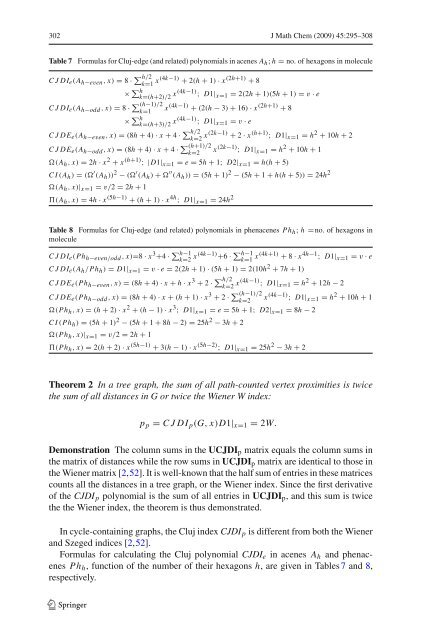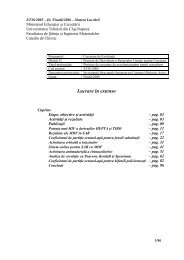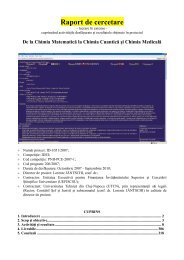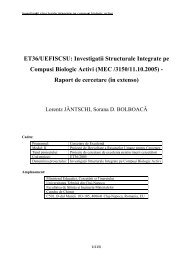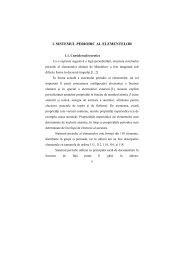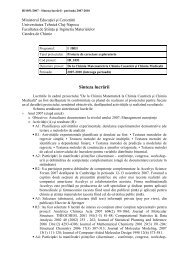Cluj polynomials
Cluj polynomials
Cluj polynomials
Create successful ePaper yourself
Turn your PDF publications into a flip-book with our unique Google optimized e-Paper software.
302 J Math Chem (2009) 45:295–308<br />
Table 7 Formulas for <strong>Cluj</strong>-edge (and related) <strong>polynomials</strong> in acenes Ah; h = no. of hexagons in molecule<br />
CJDIe(Ah−even, x) = 8 · h/2<br />
k=1 x(4k−1) + 2(h + 1) · x (2h+1) + 8<br />
× h k=(h+2)/2 x (4k−1) ; D1|x=1 = 2(2h + 1)(5h + 1) = v · e<br />
CJDIe(Ah−odd, x) = 8 · (h−1)/2<br />
k=1 x (4k−1) + (2(h − 3) + 16) · x (2h+1) + 8<br />
× h k=(h+3)/2 x (4k−1) ; D1|x=1 = v · e<br />
CJDEe(Ah−even, x) = (8h + 4) · x + 4 · h/2<br />
k=2 x(2k−1) + 2 · x (h+1) ; D1|x=1 = h2 + 10h + 2<br />
CJDEe(Ah−odd, x) = (8h + 4) · x + 4 · (h+1)/2<br />
k=2 x (2k−1) ; D1|x=1 = h2 + 10h + 1<br />
(Ah, x) = 2h · x2 + x (h+1) ;|D1|x=1 = e = 5h + 1; D2|x=1 = h(h + 5)<br />
CI(Ah) = ( ′ (Ah)) 2 − ( ′ (Ah) + ′′ (Ah)) = (5h + 1) 2 − (5h + 1 + h(h + 5)) = 24h2 (Ah, x)|x=1 = v/2 = 2h + 1<br />
(Ah, x) = 4h · x (5h−1) + (h + 1) · x4h ; D1|x=1 = 24h2 Table 8 Formulas for <strong>Cluj</strong>-edge (and related) <strong>polynomials</strong> in phenacenes Phh; h = no. of hexagons in<br />
molecule<br />
CJDIe(Phh−even/odd, x)=8 · x3 +4 · h−1 k=2 x(4k−1) +6 · h−1 k=1 x(4k+1) + 8 · x4h−1 ; D1|x=1 = v · e<br />
CJDIe(Ah/Phh) = D1|x=1 = v · e = 2(2h + 1) · (5h + 1) = 2(10h2 + 7h + 1)<br />
CJDEe(Phh−even, x) = (8h + 4) · x + h · x3 + 2 · h/2<br />
k=2 x(4k−1) ; D1|x=1 = h2 + 12h − 2<br />
CJDEe(Phh−odd, x) = (8h + 4) · x + (h + 1) · x3 + 2 · (h−1)/2<br />
k=2 x (4k−1) ; D1|x=1 = h2 + 10h + 1<br />
(Phh, x) = (h + 2) · x2 + (h − 1) · x3 ; D1|x=1 = e = 5h + 1; D2|x=1 = 8h − 2<br />
CI(Phh) = (5h + 1) 2 − (5h + 1 + 8h − 2) = 25h2 − 3h + 2<br />
(Phh, x)|x=1 = v/2 = 2h + 1<br />
(Phh, x) = 2(h + 2) · x (5h−1) + 3(h − 1) · x (5h−2) ; D1|x=1 = 25h2 − 3h + 2<br />
Theorem 2 In a tree graph, the sum of all path-counted vertex proximities is twice<br />
the sum of all distances in G or twice the Wiener W index:<br />
pp = CJDIp(G, x)D1|x=1 = 2W.<br />
Demonstration The column sums in the UCJDIp matrix equals the column sums in<br />
the matrix of distances while the row sums in UCJDIp matrix are identical to those in<br />
the Wiener matrix [2,52]. It is well-known that the half sum of entries in these matrices<br />
counts all the distances in a tree graph, or the Wiener index. Since the first derivative<br />
of the CJDIp polynomial is the sum of all entries in UCJDIp, and this sum is twice<br />
the the Wiener index, the theorem is thus demonstrated.<br />
In cycle-containing graphs, the <strong>Cluj</strong> index CJDIp is different from both the Wiener<br />
and Szeged indices [2,52].<br />
Formulas for calculating the <strong>Cluj</strong> polynomial CJDIe in acenes Ah and phenacenes<br />
Phh, function of the number of their hexagons h, are given in Tables 7 and 8,<br />
respectively.<br />
123


